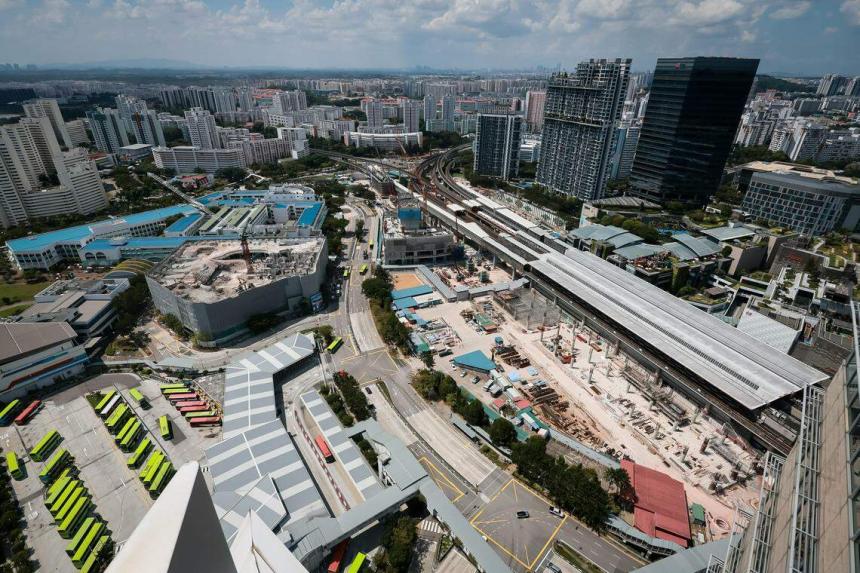SINGAPORE – How successful Singapore’s regionalism project has been, the future of city centre office spaces post-pandemic, and how cities recover post-crisis are among the key urban issues tackled in a new book.
The City Rebooted: Networks, Connectivity And Place Identities In Singapore was edited by Singapore University of Technology and Design (SUTD) honorary professor Chan Heng Chee and professorial research fellow Harvey Neo. The Straits Times unpacks some of the book’s key ideas and insights, as well as those raised during a panel discussion at the book’s launch on April 26.
Regional centres
Tampines demonstrates the highest degree of polycentricity compared with two other regional centres, Jurong and Woodlands, according to Global Positioning System data from the mobile phones of residents in those areas.
Polycentricity refers to the clustering of various human activities, such that more commuters are attracted there and fewer residents leave the area for activities. Regional centres are meant to shorten the distances that people travel from home for work or leisure.
Analysing data from 837 phones in the month of September for 2019, 2020 and 2021, Dr Neo and SUTD adjunct researcher Li Bayi found that Tampines residents travelled the shortest distances from their homes to their destinations, while Woodlands residents travelled farthest, on average, compared with those in Tampines and Jurong. When residents do not need to commute too far beyond the regional centre, it indicates higher polycentricity.
Dr Neo and Mr Li’s analysis also found that when social distancing measures were the strictest in 2020 during the Covid-19 pandemic, the average distances travelled by Tampines residents dropped the most among the three regional centres, while the reduction in distances was the smallest for Jurong residents.
Beyond meeting the functional needs of residents, the authors argued that effective regional centres need to exhibit a strong sense of place and identity, which will resonate with residents and keep them rooted in place.

Hybrid working arrangements
At a panel session on April 26, Mr Chiu Wen Tung, the Urban Redevelopment Authority’s group director for research and development, noted that more workers have returned to the office after the pandemic, suggesting that the pandemic might have been a missed opportunity to engender flexible workplace arrangements as a more permanent feature.
He said that a rethink of how to make such arrangements effective – both for employers and for employees – may be warranted, to ensure such schemes can be rolled out without affecting productivity and cohesion.
In April, the Government announced that all employers must fairly consider formal requests from employees for flexible work arrangements from Dec 1, 2024.
Citing previous studies by others, book contributors Sam Joyce, an associate professor at SUTD, and research fellow Nazim Ibrahim at the university noted that overall flexibility results in fewer chances for workers to connect, and that long-term work-from-home arrangements have largely been found to be detrimental to individual relationships and connectivity between teams.
They said that generally, the right choice of office configuration should allow for various options that balance flexibility, team engagement and collaboration across teams.
Post-pandemic city centre
Analysing Singapore’s property data, former SUTD research assistant Sara Ann Nicholas and Mr Winston Yap, a PhD candidate at the National University of Singapore’s Urban Analytics Lab, concluded that physical offices – particularly those in the city centre – remain relevant, although the industrial composition of office tenants has been shifting in recent years.
While banks continue to be headquartered in the Central Business District (CBD), much of their operations have been moved to regional centres, since before the Covid-19 pandemic.
Meanwhile, data showed that global technology firms were taking up office space in the CBD amid the Covid-19 pandemic, including ByteDance, Alibaba, Tencent, Amazon and Spotify in the fourth quarter of 2020.
Post-disaster cities
A chapter in the book explores how cities recover after a major disaster or crisis. The authors looked at three cities hit by the severe acute respiratory syndrome (Sars) in the early 2000s – Singapore, Hong Kong and Taipei – as well as three cities that suffered terror attacks – New York City, Paris and London. Across all six cities, Prof Chan and sociologist Spela Mocnik found several similarities.
First, governments prioritised reviving tourism in the wake of a disaster. Second, major communications campaigns were launched to reassure citizens and visitors that the city was safe, while political leaders pushed narratives of resilience.
Third, funding was given to businesses, especially small and medium-sized enterprises, which the authors said are “at the heart of every economy”.


